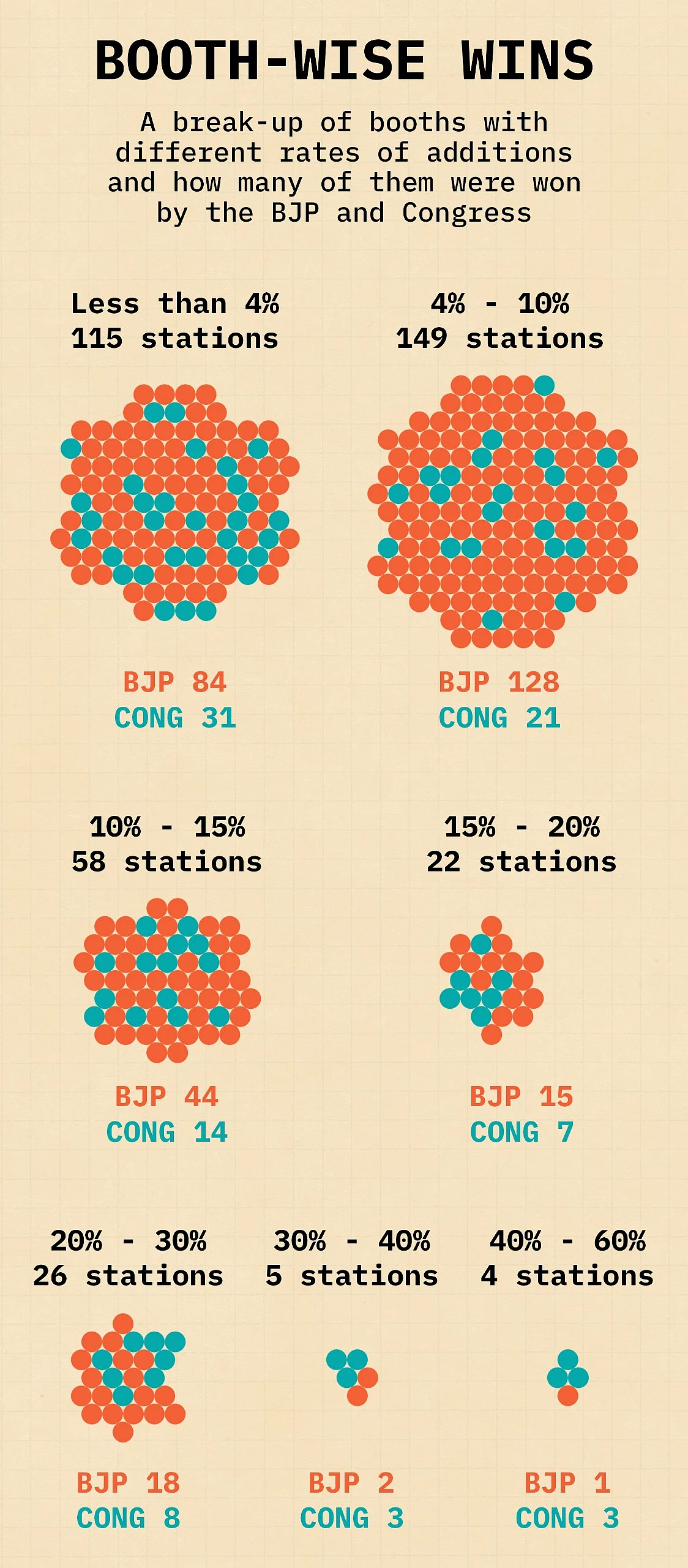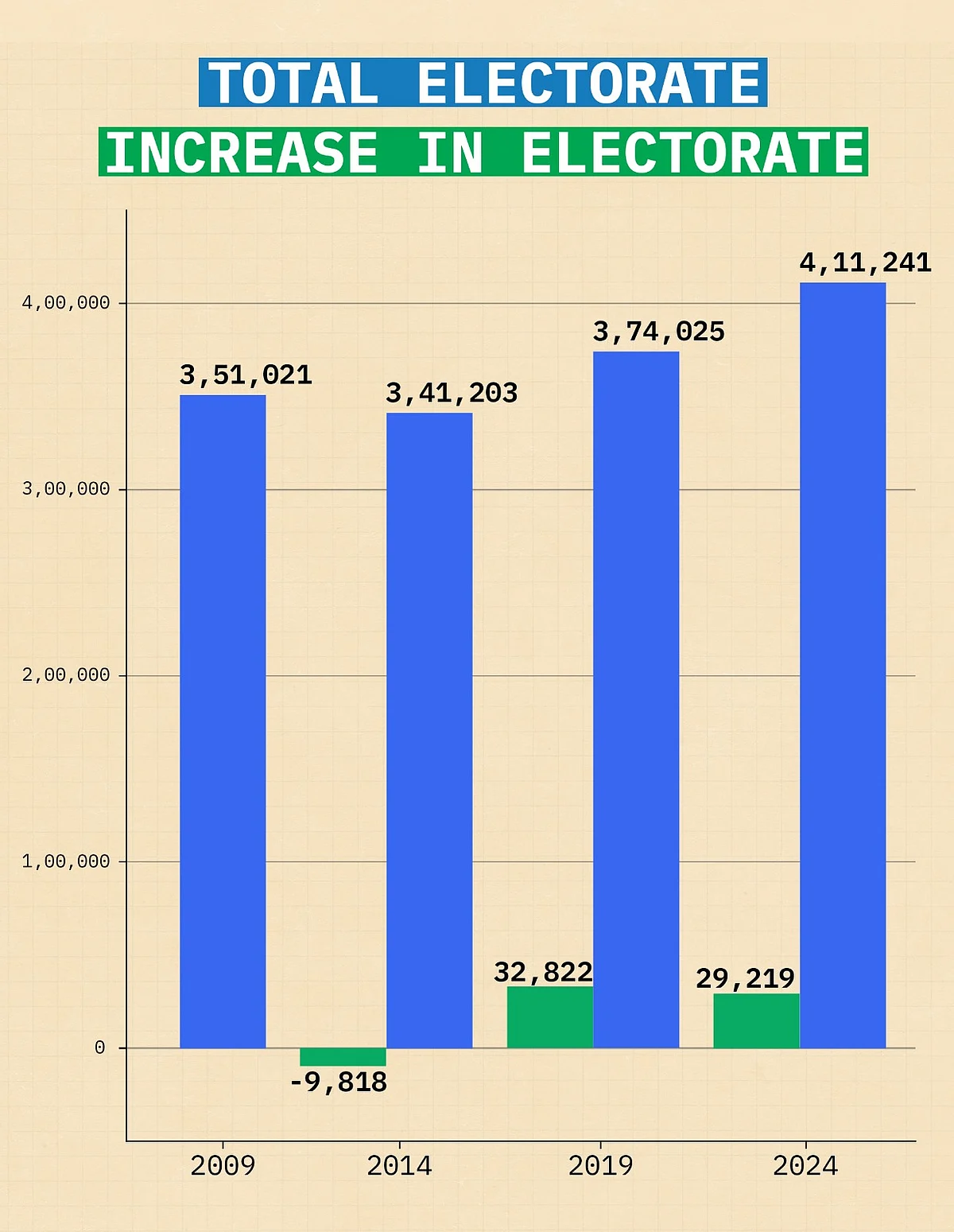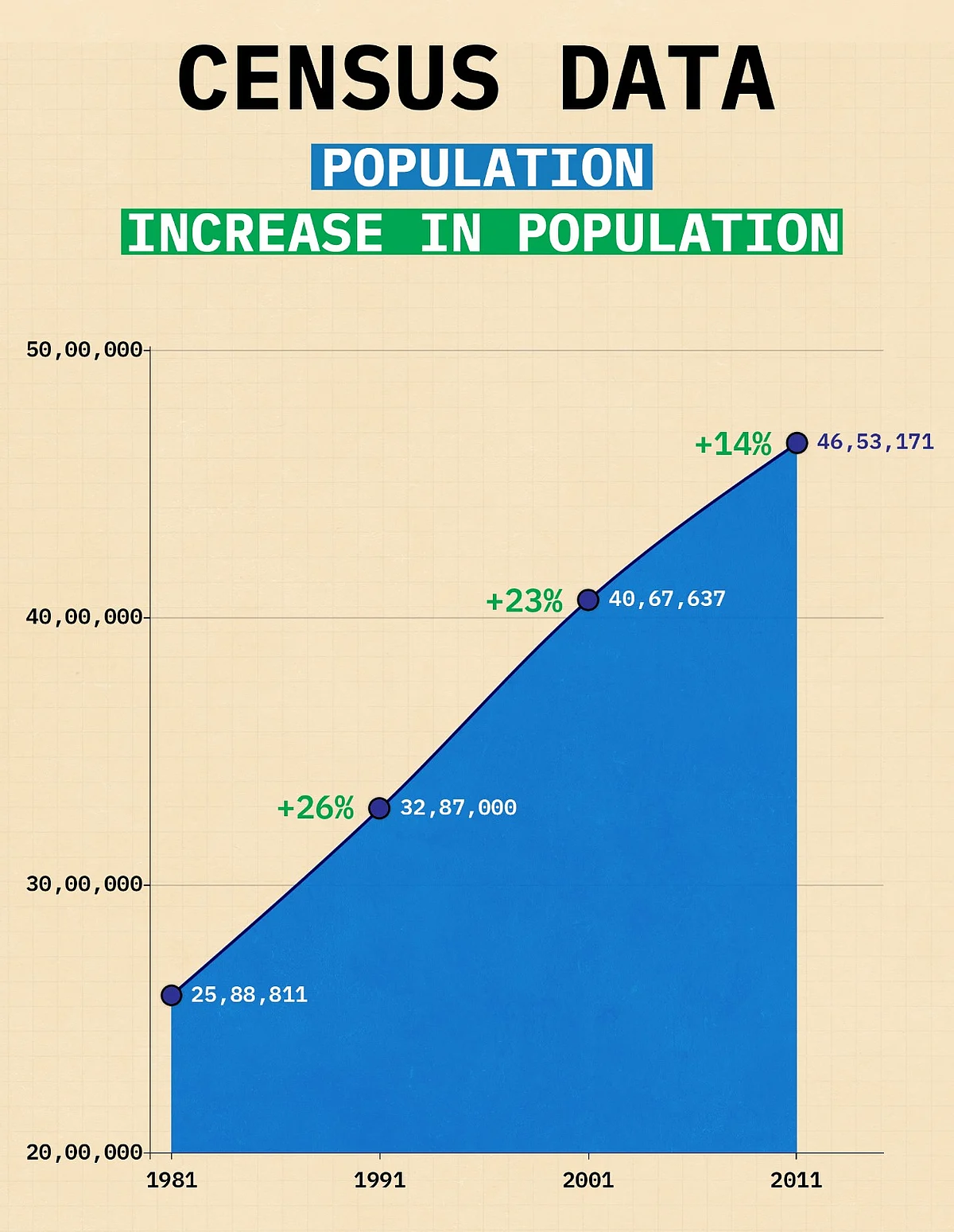In 6 months, Fadnavis seat added 29,219 voters. Poll staff claim lapses
Newslaundry found thousands of voters without addresses in Nagpur South West. EC spokesperson insists electoral roll ‘is absolutely pure’.
In just six months between the 2024 Lok Sabha elections and the Maharashtra assembly polls, Nagpur South West – the seat held by BJP leader Devendra Fadnavis – added 29,219 new voters. About 162 voters everyday. That’s a sharp 8.25 percent increase, more than double the 4 percent threshold that triggers mandatory verification checks under the Election Commission’s own guidelines.
Yet, no such checks appear to have been carried out, claimed local polling staff in some of the areas that saw the highest rates of additions.
Additionally, random checks in 50 booths by Newslaundry pointed to at least 4,000 voters with no addresses. Though it is for the Election Commission to probe whether there were bogus voters in the constituency.
Nagpur South West had also deleted 2,301 votes, or 0.6 percent of the electorate. Fadnavis had defeated Congress candidate Praful Gudadhe by 39,000 votes – it was his fourth consecutive win from the seat. As compared to the Lok Sabha polls, the BJP increased its voters by 14,225 while the Congress saw a jump of just about 8,000 votes.
The Election Commission of India has been facing a barrage of accusations from opposition parties over the last few years about discrepancies in electoral rolls. From Delhi to Uttar Pradesh, and most recently in Maharashtra, where the Congress’s Rahul Gandhi alleged “rigging”.
‘Could not trace these voters’
The Election Commission of India mandates additional layers of cross-verification by its officials where addition exceeds 4 percent and deletion by over 2 percent over previous electoral rolls. An ECI official said, “You can say 2 percent and 4 percent are kind of a threshold. Deletion is more sensitive so there the threshold is kept lower. Addition is always good, but if it is more than 4 percent, there is a reason to double check.”

Nearly 70% booths added over 4%
A closer examination of voter rolls across 378 booths in the assembly shows that 263 booths saw a jump of over 4 percent in the electorate – in 26 booths more than 20 percent and in four booths over 40 percent.
The EC manual on voter rolls as well as a note on the EC website list out a procedure to verify additions if the surge is over 4 percent. This procedure involves field verifications and multi-tier double-checking mechanisms while the voter rolls are updated.
The updation of electoral rolls in an assembly constituency is carried out by an Electoral Registration Officer, who is usually a sub divisional officer-rank bureaucrat. The ERO is assisted by a team of assistant EROs, who oversee supervisors, who in turn lead booth-level officers. The field verifications are carried out by BLOs, usually lower rung government or semigovernment employees, such as anganwadi workers, panchayat secretaries or primary school teachers.
All the additions are done through form 6, which is received online or offline by a district office. With every form, the ERO deputes a BLO to make a field visit, a report of which is then later submitted to the ERO.
There is a mechanism for supervision and checks for enforcing strict accountability of the work by the BLOs.
A supervisor, who normally has 10 BLOs under his charge, is supposed to personally verify 5 percent of each of the BLO’s verifications under him.
The manual specifies that when additions exceed 4 percent over the previous roll, AEROs need to conduct field checks on 1 percent of these additions. The EROs, apart from holding regular meetings with AEROs, supervisors and BLOs to ensure that the field verifications are not done in perfunctory manner, are also expected to carry out field verification themselves where necessary.
The manual has specified super-checks by the Chief Electoral Officer and District Electoral Officer. CEO is mandated to verify 100 forms across the states or at least five forms per district followed by field verification. The DEO has to verify 20 forms in their district covering all assemblies under their jurisdiction or at least four forms in each of the constituencies of the district.

‘Could not trace these voters’
Newslaundry reached out to over a dozen BLOs whose booths witnessed the wildest spikes in the number of voters, ranging between 20 to 58 percent, to check if thorough verifications were carried out by them. Six BLOs, including five who spoke on record, denied carrying out the verification process while the rest either refused to speak or did not respond.
The BLOs who spoke to Newslaundry claimed they had received applications in bulk via the district election office.
SP Nagwanshi, a BLO at booth 174 – the Sindhi High School’s room number 3 in Khamla – for over a decade, said that he witnessed an unprecedented spike of 24 percent at his booth. “ This time the district election office had received applications from over 300 voters…I have not signed the application form of the new voters…I have only registered 8-10 new voters…only the district office could answer that. On the polling day, I was shocked to see voters that I had never seen or even heard of turning up for voting…but on that day, it is not the BLO’s job to verify voters before letting them vote.”
BLO Sandeep Karode of booth 76 – the Ramchandra Mokhare MCVC College’s room number 1 – which saw an addition rate of 30 percent, claimed, “The district collector office had received applications for these voters which were handed over to us to verify…of which we were able to verify only a few. When we visited their addresses, their neighbours told us that these people don’t live here. We informed our supervisor about the same so they would know about it.”
Ganesh Jarwar, BLO of booth 181 – the NMC Primary School’s room number 1 in Jaitala – where 39.9 percent new voters were added, said that for his booth they had received applications to add 365 voters. “During the ground verification, I could not find addresses of voters. Because many had given wrong addresses. It is a big problem for us…Even their voter ID cards were returned, and then the district office handed over those cards to us to distribute to the voters. I checked again, and could not find them and then returned those cards to the office again.”
All these voters were added, he claimed.
Maya, supervisor to BLO Ganesh Jarwar, said that it is true that abnormally high voters were added in comparison to previous elections and a “probable” reason for it could be that the state election commission had run some programmes in colleges to encourage students to register themselves as voters.
Diwakar Bhakare, BLO of booth 189 – the Ekatmata High School’s room number 1 in Jaitala – which saw an addition rate of 58.8 percent, claimed, “The district office had handed me applications for 400 new voters…we didn’t get the time for verification…still I tried to do my best. Whose verification I was not able to do, the district office would know how they were added to the rolls.”
On booth 200, or St Joseph Primary School’s room number 1 in Jaitala, 328 new voters were added – a 30 percent rise. Its BLO Minaksi Nikose claimed, “Usually I add a new voter when a new person comes in our area. But this time we had received applications to add voters via the district office…I did not verify all these voters believing that if the district office had handed us a list of voters then it would be credible.”
We reached out to five supervisors of these BLOs. Two responded.
Maya, supervisor to BLO Ganesh Jarwar, said that it is true that abnormally high voters were added in comparison to previous elections and a “probable” reason for it could be that the state election commission had run some programmes in colleges to encourage students to register themselves as voters.
When asked if 365 new voters added to just one booth under her charge were college students, she replied, “I have no idea about it and only the BLO could tell that because we rely on them for ground verification. We don’t get time for it as we are busy with our main job. And ahead of this election, I was mostly busy with helping voters above 85 years to cast postal ballot votes.”
Motghare, the supervisor to BLO Sandeep Karode, said that he does not know the reason for the spike in voters and only the district office would be able to answer it. Asked if he was able to conduct ground verifications to cross verify additions, he disconnected the call.
In addition to this, we also found electoral rolls of the constituency replete with voters without addresses. A check on 50 booths randomly selected for this report revealed there were at least 4,393 voters with blank address columns. For example, booth 107 has 290 voters (21 percent) with untraceable addresses.
It is unclear how voters with no addresses are creeping into the rolls, when ECI requires voters to submit proof of residence along with form 6 and since the manual specifies that the address column must be filled. Even in the case of homeless voters, the BLOs enter an indicative address after a field verification in the absence of documentary proof of residence.
Last year, Navdeep Rinwa, Chief Electoral Officer of Uttar Pradesh, had told us that untraceable voters is a widespread problem in urban parts of the state and had requested the ECI to get it fixed. “There is no clear SOP by the Election Commission of India to delete such voters. If a voter’s full address is not entered at the time of registration, it becomes a huge problem at the time of deletion. Because how will the BLOs conduct their house-to-house verification and where will we send notices informing them about the deletion of their vote,” he had said.
Responding to a questionnaire by Newslaundry, an EC spokesperson said that “any increase or decrease can happen” and that “migration has become very mobile”. “Depending on the voter list updation time, we follow the whole process. There are BLOs, booth level agents, claims and objections. Everything gets settled after that. So, it’s natural growth.”
On the question of blank addresses, the spokesperson said, “The voters with no addresses means the voters who are residing in an area”. The EC registers them as new voters if “they are the citizens of India, if they are 18 plus and if they are temporarily residing in some area with no exact address” and are “able to provide some documentation which proves that the voter resides in that area and after ground level verification by our BLO”.
“I am just here to tell you the current clear legal position…there was no problem in the Maharashtra elections. Our electoral roll is absolutely pure,” the spokesperson added.
Newslaundry made several attempts to reach out to ERO Suresh Bagale and DEO Pravin Mahire via calls and text but neither of them responded. We have sent a detailed questionnaire to Maharashtra CEO S Chockalingam and the ECI asking if they document findings from the field verification done by senior poll officials. This copy will be updated if they respond.
Speaking about the issue of lack of address details, Bhandara district DEO Prashant Pisal claimed it is because applicants “do not mention the detailed address in their online form” despite attaching “proper documents”. “So this results in reflection of that particular data in the voter list.”
It is the ERO’s responsibility to check the voter roll for any deviant trend in polling station-wise additions as compared to the projected population data.
Newslaundry made several attempts to reach out to ERO Suresh Bagale and DEO Pravin Mahire via calls and text but neither of them responded. We have sent a detailed questionnaire to Maharashtra CEO S Chockalingam and the ECI asking if they document findings from the field verification done by senior poll officials. This copy will be updated if they respond.
‘Such inflow not normal’
This is among the largest increases in the electorate since 2009. In the run-up to the 2019 Lok Sabha polls, 32,822 voters were added to the assembly constituency.


The Census profile of Nagpur district suggests a population increase of 14 percent between 2001 and 2011. The rate of growth was lower as compared to the decade before.
AR Nanda, former Registrar General and Census Commissioner of India, said, “If the population of Nagpur is not experiencing some sudden increase then it does not make sense for voter rolls to show this. In 1988, we had seen a sudden jump in voters because the voting age was reduced to 18 and younger people came in.”
Jagdeep S Chhokar, founder of the Association for Democratic Reforms, said, “If a multi-storied high-rise residential building came up in an area, and new people moved in then that kind of exchange might explain a sudden spurt. Other than that, if there is no such major physical occurrence or event to a city and the inflow of migration has also not increased…especially when ECI revises voter rolls every year…I don’t see an inflow of voters double the usual as normal. And if there is an increase in voters going up to 50 to 60 percent, then this certainly requires an explanation from the commission.”
Vishal Vaibhav is a former assistant professor and alumnus of the IIT-Delhi department of physics.
Contribute now to power our upcoming investigative series on the broken e-waste system in India. Subscribe to support public interest journalism.
